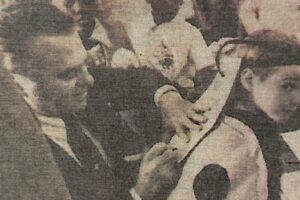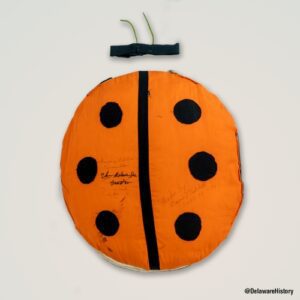

Mollie Brown’s second grade class at Legislative Hall asking to name the ladybug the state bug (Photo courtesy of Lulu Ross)
On April 25, 1974, 19 second graders from Ms. Mollie Brown’s class at Lulu M. Ross Elementary School made state history when they stood by in Legislative Hall and watched as the ladybug was officially chosen as the Delaware state bug. They were also present when then Governor Sherman W. Tribbitt signed the legislation into law later that day. This was a move that had taken several months for the children to achieve.
“Move over state bird. Move over state flower, Now Maryland has a state ‘bug.” The bug is a butterfly. All states have a state flower and bird, but Maryland may be the first state to have a state bug,” Brown wrote in 1974 when the idea grew in the minds of her young students. “It was just a short article of six sentences that started the whole idea of a state bug for Delaware.”
The short story was in a “Weekly Reader,” publication children often read in elementary school, but Brown was not aware those six short sentences would inspire her students into action. It began with a lengthy discussion about what the Delaware state bug could be and the contenders were narrowed down to the cricket, the mosquito and the ladybug. The cricket was quickly ruled out as they ate clothing and the mosquito since the children were not fond of their bites. Mark Mullen, one of the students in the class brought in a ladybug.


Governor Tribbitt signs the legislation on the back of Michael Peterman wearing a handmade ladybug costume (Photo courtesy of Delaware State Archives)
“A series of events followed. First, the students composed a letter to send to our Honorable Governor Tribbitt, asking him to help us get the state bug. Shortly following this, Governor and Mrs. Tribbitt were the guests of my class to have lunch at our school during National School Lunch Week,” Brown wrote. “He spent time talking to the children about the state bug and what steps they should take to accomplish this. Representative Lewis Harrington also visited and agreed to help us.”
The students in the class included Emerson Akins, Veronica Bynum, Sharita Green, Mary Gillespie, Joseph Harris, Annette Mullen, Mark Mullen, Michael Peterman, Jennifer Riddick, Naomi Riddick, Darryl Sanders, Billy Walls, Jackie Waples, Evette Welch, Sharon White, Vonda Williams and Vickie Wood.
“We had an opportunity to do a little campaigning at the Democratic dinner that was held on April 9, 1974, in our school,” Brown wrote. “Ann Postles, our cafeteria manager, was in charge of the dinner. She asked us to help with the table and room decorations. The teachers and the children all helped. WE made big bug posters to put on the walls, badges for all the waitresses to wear, individual place cards with a ladybug and an American flag on each one. Mrs. Donovan went to the dinner and did a little lobbying. Mrs. Brown gave ladybug pins to all the honored guests. The [then] Honorable Senator Joseph Biden was the speaker. We won a lot of support for the ladybug that night.”


One of the handmade ladybug costumes worn by two students from Mrs. Brown’s second grade class (Photo courtesy of Delaware Public Archives)
Over the months of planning, Brown had students prepare speeches. Sharita Green and Mark Mullen were both selected to speak to the legislators.
“The ladybug is round in shape and flat on the bottom. Most are orange, yellow or red with black dots. Some are black with orange or red dots. Both the adult and larvae feed on pests such as aphids and scale insects,” Green said. “Sometimes ladybugs are sold to grove owners to help save the fruit trees because they eat the aphids that will kill the fruit trees, especially the apple, cherry and peach tree.”
Mullen pointed out that there was another reason to choose the ladybug.
“We have a state flat which is blue and gold. We have a state tree, the holly tree,” Mullen said. “We have a state bird, the blue hen chicken. We have a state flower, the peach blossom. The ladybug helps to save the state flower, the peach blossom.”
Arriving at Legislative Hall that day, the children were expecting the “White House,” so Brown had to explain it to them. Michael Peterman and Sammy Mullen dressed in ladybug costumes handmade by two teacher’s aides, Jean Pyne and Bonnie Pritchett, while the girls all wore ladybug skirts they helped Pyne make. Representative Harrington called for a vote after the children spoke and, initially, only Representative Boulden voted no, but changed his vote to yes so it would be unanimous.
The children then headed to the State Senate chambers where Senator Thurman Adams sponsored the bill, and the vote was unanimous. They then went to the Governor’s Office where the bill was signed on Michael Peterman’s back.
In honor of the 50th anniversary of the perseverance of Mrs. Brown’s second grade class in naming the ladybug the Delaware state bug, Downtown Milford Inc. (DMI) will hold a special ceremony at this year’s Bug and Bud Festival.
“We have invited Claudia Leister of the Milford Museum to read a brief history of how the ladybug was designated the state bug,” Sara LeBright, Executive Director of DMI said. “We are trying to identify students who were in that class and would love to have them join her on the stage to be recognized. We did hear back from Crystal Mullen, Mark Mullen’s wife, and he will be attending the ceremony that day. We are hoping many others will want to join us to be recognized.”
Milford’s Bug and Bud Festival is planned for Saturday, April 27 from 9 AM to 4 PM. The ladybug recognition is planned at the library amphitheater around 10:15 AM. Members of the class who plan to attend who want more information can contact DMI at 302-839-1180 or email [email protected].
Share this Post


